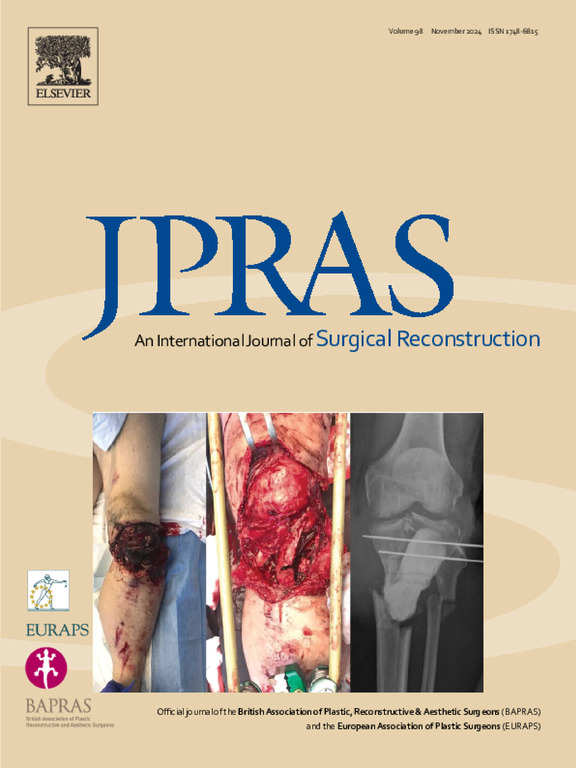70 岁及以上患者的游离皮瓣乳房重建效果:单中心经验
IF 2
3区 医学
Q2 SURGERY
Journal of Plastic Reconstructive and Aesthetic Surgery
Pub Date : 2024-09-24
DOI:10.1016/j.bjps.2024.09.059
引用次数: 0
摘要
研究背景 年龄是决定乳腺癌术后能否进行乳房再造的一个重要因素。游离皮瓣乳房再造被认为是金标准,但由于风险太高,很少为老年患者提供。本研究旨在探讨在我院接受治疗的年龄≥70岁患者的游离皮瓣乳房重建结果。方法我们进行了一项回顾性研究,探讨了2015年1月至2023年12月期间在一个中心接受游离皮瓣乳房重建的年龄≥70岁的连续患者的结果。我们使用逻辑回归来确定年龄增加、合并症和四个主要结果变量(所有并发症、再入院、重返手术室和住院时间)之间的关系。结果我们确定了71名平均年龄为72.3岁(70-78岁)的患者。63.4%的患者患有一种或多种并发症,其中最常见的是高血压和高胆固醇血症。大多数患者(90.1%)为美国麻醉医师协会(ASA)1级或2级。总体并发症发生率为36.6%,其中大部分是轻微的伤口愈合并发症(22.5%)。没有出现皮瓣部分或完全脱落的情况。严重并发症发生率(14.1%)、再入院率(8.4%)和重返手术室率(7.0%)都很低,与之前公布的普通患者群体的发生率相当。结论年龄超过70岁的患者进行游离皮瓣乳房重建手术是成功和安全的。因此,对于身体健康、手术优化的患者,无论年龄大小,都应将其视为一种选择。本文章由计算机程序翻译,如有差异,请以英文原文为准。
Outcomes of free flap breast reconstruction in patients aged 70 years and over: A single-centre experience
Background
Chronological age is an important factor in determining whether a patient can be offered reconstruction following breast cancer surgery. Free flap breast reconstruction is considered the gold standard but is seldom offered to older patients, as the risks are considered too high. This study aimed to examine the outcomes of free flap breast reconstruction in patients aged ≥70 years treated in our unit.
Methods
We conducted a retrospective review examining the outcomes of consecutive patients aged ≥70 years undergoing free flap breast reconstruction at a single centre between January 2015 and December 2023. Logistic regression was used to determine the relationship between increasing age and comorbidities, and four primary outcome variables— all complications, readmission, return to theatre and length of stay.
Results
We identified 71 patients with a mean age of 72.3 years (70–78 years). 63.4% had one or more comorbidities, with the most common being hypertension and hypercholesterolaemia. Most patients (90.1%) were American Society of Anesthesiologists (ASA) grade 1 or 2. The overall complication rate was 36.6%, most of which were minor wound healing complications (22.5%). There were no episodes of flap loss, either partial or complete. The rates of severe complications (14.1%), readmission (8.4%) and return to theatre (7.0%) were low and comparable to those previously published for our general patient cohort. There was no relationship between increasing age beyond 70 years and any of the four primary adverse outcome measures.
Conclusions
Free flap breast reconstruction in patients aged ≥70 years can be successful and safe. Therefore, it should be considered as an option for fit, surgically optimised patients, independent of age.
求助全文
通过发布文献求助,成功后即可免费获取论文全文。
去求助
来源期刊
CiteScore
3.10
自引率
11.10%
发文量
578
审稿时长
3.5 months
期刊介绍:
JPRAS An International Journal of Surgical Reconstruction is one of the world''s leading international journals, covering all the reconstructive and aesthetic aspects of plastic surgery.
The journal presents the latest surgical procedures with audit and outcome studies of new and established techniques in plastic surgery including: cleft lip and palate and other heads and neck surgery, hand surgery, lower limb trauma, burns, skin cancer, breast surgery and aesthetic surgery.

 求助内容:
求助内容: 应助结果提醒方式:
应助结果提醒方式:


